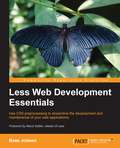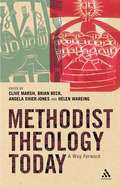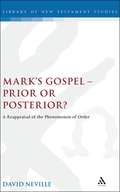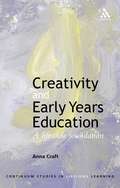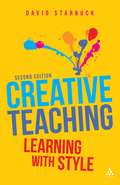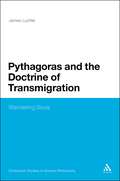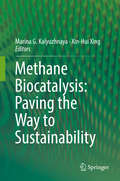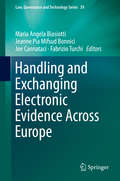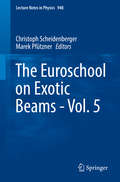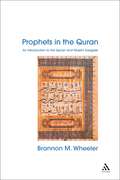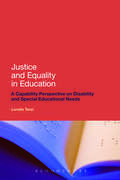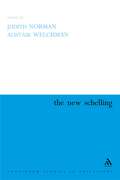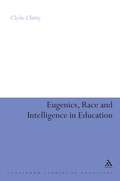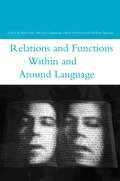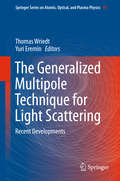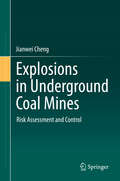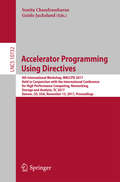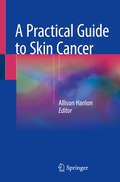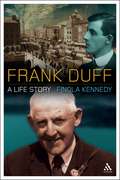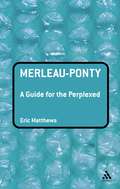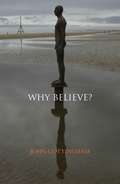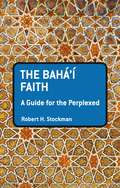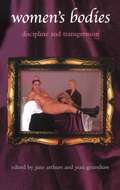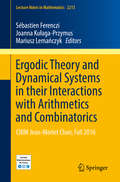- Table View
- List View
Less Web Development Essentials
by Bass JobsenWritten in a practical and concise manner, this book is a crash-course in teaching you the fundamental concepts of Less with real-life examples and problems. If you use CSS(3) in your web development tasks and would love to learn how to create maintainable and reusable code with Less, this book is ideal for you. Although you need to have some experience in web development, even beginners will find that this book is useful.
Methodist Theology Today
by Clive MarshBritish Methodism is reshaping itself. At a time of uncertainty about the future, owing to declining numbers and an ever-closer relationship with the Church of England, a collection of the liveliest theological minds in contemporary Methodism have written a book which shows how recent theology can be a resource for the future. Methodism has always had an active concern with both evangelism and social welfare and by means of its central organization it is able to coordinate efforts in these areas. The book asks challenging questions about how this may develop in the complex post-modern secular world.
Mark's Gospel--Prior or Posterior?: A Reappraisal of the Phenomenon of Order (The Library of New Testament Studies #222)
by David NevilleThe similarities and difference of arrangement and order of episodes in the gospels of Mark, Matthew and Luke have always been one of the major critera for resolving the Synoptic Problem. How important, and how reliable are arguments based on such considerations, and where might they lead? Here Neville reviews these issues in detail, explaining the significance of his conclusions for understanding the literary relationships among the three Synoptics gospels, and particularly for the competing theories of Markan priority (the standard two-source hypothesis) and Markan posteriority (the Griesbach hypothesis).
Creativity and Early Years Education: A lifewide foundation (Continuum Studies in Lifelong Learning)
by Anna CraftMost people accept that early years education should aim to develop children's creativity, but this raises a number of questions: What is creativity? How does it relate to such concepts as imagination, self-expression and intelligence? Why is it valuable?--and in what ways? Can creativity be taught? And, if so, how? And how can it be assessed?In this carefully-weighed, clearly written and scholarly study, Anna Craft answers these and related questions, providing in the process a comprehensive guide to creativity for all those who work with children in the early years.
Creative Teaching: Learning with Style
by David StarbuckFindout how you can be more creative and encourage more creativity from yourstudents without having to put in hours of extra preparation. This concise,practical guide will help you to gain the confidence to move out of yourcomfort zone and take some risks, in order to meet the needs of students with avariety of learning styles and needs. Thisupdated edition of Creative Teaching includes practical activities and avariety of strategies to help you to plan exciting, pupil-centred lessons thatare easy to integrate into your schemes of work. There is newmaterial on: • independent learning - offering a clear framework for design, delivery andassessment of lessons• transforming the ethos of the school to a positive, creative one• the companion website - offering printable or downloadable checklists,questionnaires and templates. Alongwith adaptable action plans for improving both your classroom and whole-schoolethos, this book creates a cohesive picture of how teachers can make learningeasier and more enjoyable for themselves and their pupils.
Pythagoras and the Doctrine of Transmigration: Wandering Souls (Continuum Studies in Ancient Philosophy)
by James LuchteThe mythical narrative of transmigration tells the story of myriad wandering souls, each migrating from body to body along a path of recurrence amid the becoming of the All. In this highly original study, James Luchte explores the ways in which the concept of transmigration is a central motif in Pythagoras' philosophy, representing its fundamental meaning. Luchte argues that the many strands of the tale of transmigration come together in the Pythagorean philosophical movement, revealing a unity in which, for Pythagoreans, existence and eschatology are separated only by forgetfulness. Such an interpretation that seeks to retrieve the unity of Pythagorean thought goes against the grain of a long-standing tradition of interpretation that projects upon Pythagoras the segregation of 'mysticism' and 'science'. Luchte lays out an alternative interpretation of Pythagorean philosophy as magical in the sense that it orchestrates a holistic harmonization of theoria and praxis and through this reading discloses the radical character of Pythagorean philosophy.
Methane Biocatalysis: Paving the Way to Sustainability
by Marina G. Kalyuzhnaya Xin-Hui XingThis book provides in-depth insights into the most recent developments in different areas of microbial methane and methanol utilization, including novel fundamental discoveries in genomics and physiology, innovative strategies for metabolic engineering and new synthetic approaches for generation of feedstocks, chemicals and fuels from methane, and finally economics and the implementation of industrial biocatalysis using methane consuming bacteria. Methane, as natural gas or biogas, penetrates every area of human activity, from households to large industries and is often promoted as the cleanest fuel. However, one should not forget that this bundle of energy, carbon, and hydrogen comes with an exceptionally large environmental footprint. To meet goals of long-term sustainability and human well-being, all areas of energy, chemicals, agriculture, waste-management industries must go beyond short-term economic considerations and target both large and small methane emissions. The search for new environment-friendly approaches for methane capture and valorization is an ongoing journey. While it is not yet apparent which innovation might represent the best solution, it is evident that methane biocatalysis is one of the most promising paths. Microbes are gatekeepers of fugitive methane in Nature. Methane-consuming microbes are typically small in number but exceptionally big in their impact on the natural carbon cycle. They control and often completely eliminate methane emission from a variety of biological and geothermal sources. The tremendous potential of these microbial systems, is only now being implemented in human-made systems. The book addresses professors, researchers and graduate students from both academia and industry working in microbial biotechnology, molecular biology and chemical engineering.
Handling and Exchanging Electronic Evidence Across Europe (Law, Governance and Technology Series #39)
by Maria Angela Biasiotti Jeanne Pia Mifsud Bonnici Joe Cannataci Fabrizio TurchiThis volume offers a general overview on the handling and regulating electronic evidence in Europe, presenting a standard for the exchange process. Chapters explore the nature of electronic evidence and readers will learn of the challenges involved in upholding the necessary standards and maintaining the integrity of information. Challenges particularly occur when European Union member states collaborate and evidence is exchanged, as may be the case when solving a cybercrime. One such challenge is that the variety of possible evidences is so wide that potentially anything may become the evidence of a crime. Moreover, the introduction and the extensive use of information and communications technology (ICT) has generated new forms of crimes or new ways of perpetrating them, as well as a new type of evidence. Contributing authors examine the legal framework in place in various EU member states when dealing with electronic evidence, with prominence given to data protection and privacy issues. Readers may learn about the state of the art tools and standards utilized for treating and exchanging evidence, and existing platforms and environments run by different Law Enforcement Agencies (LEAs) at local and central level. Readers will also discover the operational point of view of LEAs when dealing with electronic evidence, and their requirements and expectations for the future. Finally, readers may consider a proposal for realizing a unique legal framework for governing in a uniform and aligned way the treatment and cross border exchange of electronic evidence in Europe. The use, collection and exchange of electronic evidence in the European Union context and the rules, practises, operational guidelines, standards and tools utilized by LEAs, judges, Public prosecutors and other relevant stakeholders are all covered in this comprehensive work. It will appeal to researchers in both law and computer science, as well as those with an interest in privacy, digital forensics, electronic evidence, legal frameworks and law enforcement.
Algorithmic Aspects of Cloud Computing: Third International Workshop, ALGOCLOUD 2017, Vienna, Austria, September 5, 2017, Revised Selected Papers (Lecture Notes in Computer Science #10739)
by Dan Alistarh Alex Delis George PallisThis book constitutes the thoroughly refereed post-conference proceedings of the Second International Workshop on Algorithmic Aspects of Cloud Computing, ALGOCLOUD 2017, held in Vienna, Austria, in September 2017.The 9 revised full papers were carefully reviewed and selected from 27 submissions. The aim of the workshop is to present research activities and results on topics related to algorithmic, design, and development aspects of modern cloud-based systems.
The Euroschool on Exotic Beams - Vol. 5 (Lecture Notes in Physics #948)
by Christoph Scheidenberger Marek PfütznerThis is the fifth volume in a series of Lecture Notes based on the highly successful Euro Summer School on Exotic Beams.The aim of these notes is to provide a thorough introduction to radioactive ion-beam physics at the level of graduate students and young postdocs starting out in the field.Each volume covers a range of topics from nuclear theory to experiment and applications. Vol I has been published as LNP 651, Vol II as LNP 700, Vol. III as LNP 764 and Vol. IV as LNP 879.
Prophets in the Quran: An Introduction to the Quran and Muslim Exegesis (Comparative Islamic Studies)
by Brannon WheelerWhat was the name of Noah's son who did not survive the Flood? Why do Pharaoh and Haman build the Tower of Babel? For what reasons does Moses travel to the ends of the Earth? Who is the 'Horned-One' who holds back Gog and Magog until the Day of Judgement? These are some of the questions answered in the oral sources and Quran commentaries on the stories of the prophets as they are understood by Muslims. Designed as an introduction to the Quran with particular emphasis on parallels with Biblical tradition, this book provides a concise but detailed overview of Muslim prophets from Adam to Muhammad. Each of the chapters is organized around a particular prophet, including an English translation of the relevant verses of the Quran and a wide selection of classical, medieval and modern Muslim commentaries on those verses. Quran commentaries include references to Sunni and Shi'i sources from Spain, Central Asia, the Middle East and Africa. An extensive glossary provides an annotated list of all scholarly transmitters and cited texts with suggestions for further reading.This is an excellent book for undergraduate courses, and students in divinity and seminary programmes. Comparisons between the Quran and Bible, and among Jewish, Christian and Islamic exegesis are highlighted. Oral sources, references adapted from apocryphal and pseudepigraphical works, and inter-religious dialogue are all evident throughout these stories of the prophets. This material shows how the Quran and its interpretation are integral to a fuller and more discerning understanding of the Bible and its place in the history of Western religion.
Justice and Equality in Education: A Capability Perspective on Disability and Special Educational Needs
by Lorella TerziLorella Terzi offers a philosophical conception of justice and equality in education, examining the demands of disability and special educational needs.
The New Schelling
by Judith Norman Alistair WelchmanFriedrich Wilhelm Joseph Von Schelling (1775-1854) was a colleague of Hegel, Holderlin, Fichte, Goethe, Schlegel, and Schiller. Always a champion of Romanticism, Schelling advocated a philosophy which emphasized intuition over reason, which maintained aesthetics and the creative imagination to be of the highest value. At the same time, Schelling's concerns for the self and the rational make him a major precursor to existentialism and phenomenology.The New Schelling brings together a wide-ranging set of essays which elaborate the connections between Schelling and other thinkers-such as Marx, Nietzsche, Freud, Sartre, Deleuze, and Lacan-and argue for the unexpected modernity of Schelling's work.Contributors: Manfred Frank, Jürgen Habermas, Iain Hamilton Grant, Joseph Lawrence, Odo Marquand, Judith Norman, Alberto Toscano, Michael Vater, Alistair Welchman, Slavoj Š ZiŠ zek.
Eugenics, Race and Intelligence in Education
by Clyde ChittyFor over a hundred years, psychologists and human biologists have been engaged in an often heated debate as to whether 'heredity' or 'environment' should be viewed as the determining factor in the creation of the human personality. For teachers and educationists, the discussion has tended to focus on how the human mind functions and intellectual powers develop. The controversy is often simply expressed in terms of 'nature' versus 'nurture,' with some scientists declaring that human beings are a product of a transaction between the two. To many, such enquiry and speculation is little more than futile and depressing. Yet it can surely be argued that at least with regard to the development of abilities, the 'nature' versus 'nurture' debate has had dire consequences for the education of millions of young people. Furthermore, we need to question why this debate has been pursued with such vigour in both Britain and America.
Relations and Functions within and around Language
by Michael Cummings Peter Fries David Lockwood William SpruiellThis book describes language as a network of functional relations involving a context which is also a network of functional relations. Part I presents essays from a variety of perspectives on the theory of language as functional relations. Part II presents essays which describe an oral text from a variety of functional perspectives. All of the essays are by linguists interested in oral and written texts who have achieved international recognition in their fields. Illustrated in this book are cognitive, social construction, social praxis and anthropological approaches to the description of text. Currently in linguistics there is a movement towards careful use of corpora in linguistic and text analysis. This movement has involved the use of written corpora, spoken corpora and corpora which consist of combinations of spoken and written text. But little detailed discussion of the language of oral texts has been published. Most text analyses address written texts -- often literary works. This book is among the first to integrate the analysis of the language of spoken and written texts.
The Generalized Multipole Technique for Light Scattering: Recent Developments (Springer Series on Atomic, Optical, and Plasma Physics #99)
by Thomas Wriedt Yuri EreminThis book presents the Generalized Multipole Technique as a fast and powerful theoretical and computation tool to simulate light scattering by nonspherical particles. It also demonstrates the considerable potential of the method. In recent years, the concept has been applied in new fields, such as simulation of electron energy loss spectroscopy and has been used to extend other methods, like the null-field method, making it more widely applicable. The authors discuss particular implementations of the GMT methods, such as the Discrete Sources Method (DSM), Multiple Multipole Program (MMP), the Method of Auxiliary Sources (MAS), the Filamentary Current Method (FCM), the Method of Fictitious Sources (MFS) and the Null-Field Method with Discrete Sources (NFM-DS). The Generalized Multipole Technique is a surface-based method to find the solution of a boundary-value problem for a given differential equation by expanding the fields in terms of fundamental or other singular solutions of this equation. The amplitudes of these fundamental solutions are determined from the boundary condition at the particle surface. Electromagnetic and light scattering by particles or systems of particles has been the subject of intense research in various scientific and engineering fields, including astronomy, optics, meteorology, remote sensing, optical particle sizing and electromagnetics, which has led to the development of a large number of modelling methods based on the Generalized Multipole Technique for quantitative evaluation of electromagnetic scattering by particles of various shapes and compositions. The book describes these methods in detail.
Explosions in Underground Coal Mines: Risk Assessment and Control
by Jianwei ChengThis book addresses the hazard of gas explosions in sealed underground coal mines, and how the risk of explosion can be assessed, modeled, and mitigated. With this text, coal mine operators and managers will be able to identify the risks that lead to underground mine gas explosions, and implement practical strategies to optimize mining safety for workers. In six chapters, the book offers a framework for understanding the sealed coal mine atmosphere, the safety characteristics that are currently in place, and the guidelines to be followed by engineers to improve upon these characteristics. The first part of the book describes the importance and characteristics of underground gas mine explosions in a historical context with data showing the high number of fatalities from explosion incidents, and how risk has been mitigated in the past. Chapters also detail mathematical models and explosibility diagrams for determining and understanding the risk factors involved in mine explosions. Readers will also learn about safety operations, and assessments for the sealed mine atmosphere. With descriptions of chapter case studies, mining engineers and researchers will learn how to apply safety measures in underground coal mines to improve mining atmospheres and save lives.
Accelerator Programming Using Directives: 4th International Workshop, WACCPD 2017, Held in Conjunction with the International Conference for High Performance Computing, Networking, Storage and Analysis, SC 2017, Denver, CO, USA, November 13, 2017, Proceedings (Lecture Notes in Computer Science #10732)
by Sunita Chandrasekaran Guido JuckelandThis book constitutes the refereed post-conference proceedings of the 4th International Workshop on Accelerator Programming Using Directives, WACCPD 2017, held in Denver, CO, USA, in November 2017.The 9 full papers presented have been carefully reviewed and selected from 14 submissions. The papers share knowledge and experiences to program emerging complex parallel computing systems. They are organized in the following three sections: applications; environments; and program evaluation.
A Practical Guide to Skin Cancer
by Allison HanlonSkin cancer is the most common malignant neoplasm, and with the increasing regularity of such tumors comes the need for a practical guide for medical professionals to reference for diagnosis, management, and treatment. This book covers everything from the epidemiology of the skin cancer, clinical presentation with clinical photographs, diagrams of the most common anatomical locations, to histological descriptions, special stains/tests for diagnosis, and a treatment algorithm in chart form. A Practical Guide to Skin Cancer offers brief and succinct chapters with pertinent references, as well as high quality color photographs, diagrams, tables, and charts. Written for dermatologists, dermatology residents, and oncologists, this book allows for the reader to quickly and easily obtain the information regarding a tumor’s clinical presentation, patient evaluation and treatment algorithms, proving essential for every physician who encounters these tumors in their daily practice.
Frank Duff: A Life Story
by Finola KennedyThe Irish Times described Frank Duff as 'the founder of the largest international association that has originated in Ireland. Yet he has been, among Irish leaders of his generation, the least publicised.' Duff was not only a major religious figure; he also had a distinct influence on the evolution of modern Irish society. A friend of Irish leaders including Michael Collins, W. T. Cosgrave and Éamon de Valera, he avoided the cult of celebrity which might well have befallen him as the founder of an organisation which today has over four million active members and ten million auxiliary members in more than one hundred and seventy countries. Like most saintly people, his greatest opposition came from local Church figures and this is a vital part of the story.
Merleau-Ponty: A Guide for the Perplexed (Guides for the Perplexed)
by Eric MatthewsMaurice Merleau-Ponty was one of the most important figures in the existential and phenomenological traditions in twentieth-century Continental philosophy. Merleau-Ponty: A Guide for the Perplexed is the ideal text for students encountering Merleau-Ponty's philosophy for the first time. The book assumes no prior knowledge of the subject, and takes the reader though the key themes in Merleau-Ponty's work, casting light on complex ideas, including - crucially - his interpretations of 'perception', 'embodiment' and 'behaviour'. Most importantly this Guide for the Perplexed offers a full and authoritative explication of Merleau-Ponty's phenomenological account of human behaviour.
Why Believe?
by John CottinghamWhy Believe? sees John Cottingham, a philosopher of searing intellectual honesty, examine our society's struggle with the concept of belief.Cottingham's carefully reasoned yet impassioned account shows how the religious outlook connects with our deepest human longings, how it links up with our moral and aesthetic experience, how it is integrally involved in the quest for self understanding, and how it is not after all in conflict with a scientific understanding of the world.
The Baha'i Faith: A Guide For The Perplexed (Guides for the Perplexed)
by Robert H. StockmanFounded by Bahá'u'llah in Iran in the 19th century, the Bahá'í Faith is one of the youngest of the world's major religions. Though it has over 5 million followers worldwide, it is still little understood outside of its own community. The Bahá'í Faith: A Guide for the Perplexed explores the utopian vision of the Bahá'í Faith including its principles for personal spiritual transformation and for the construction of spiritualized marriages, families, Bahá'í communities, and, ultimately, a spiritual world civilization. Aimed at students seeking a thorough understanding of this increasingly studied religion, this book is the ideal companion to studying and understanding the Bahá'í Faith, its teachings and the history of its development.
Women's Bodies: Cultural Representations and Identity
by Jane Arthurs Jean GrimshawThe articles in this volume consider the prevailing standards of feminine decorum, and how these are being played with and challenged by various media. This is a collection of essays which focuses on the representation of women's bodies in historical and contemporary cultures. It discusses recent books on the subject, and compares the two different approaches to the body adopted by the soft-porn magazine "For Women", and the women's monthly "Cosmopolitan". It also examines TV cult figures, such as the "comic body" exemplified by comedienne Joe Brand, and situation comedies such as "Absolutely Fabulous".
Ergodic Theory and Dynamical Systems in their Interactions with Arithmetics and Combinatorics: CIRM Jean-Morlet Chair, Fall 2016 (Lecture Notes in Mathematics #2213)
by Sébastien Ferenczi Joanna Kułaga-Przymus Mariusz LemańczykThis book concentrates on the modern theory of dynamical systems and its interactions with number theory and combinatorics. The greater part begins with a course in analytic number theory and focuses on its links with ergodic theory, presenting an exhaustive account of recent research on Sarnak's conjecture on Möbius disjointness. Selected topics involving more traditional connections between number theory and dynamics are also presented, including equidistribution, homogenous dynamics, and Lagrange and Markov spectra. In addition, some dynamical and number theoretical aspects of aperiodic order, some algebraic systems, and a recent development concerning tame systems are described.
